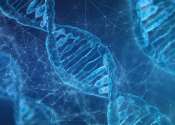New method enables amplifiable protein identification from trace samples
In a study published in the journal National Science Review, researchers developed an amplifiable protein identification method called "AmproCode."

In a study published in the journal National Science Review, researchers developed an amplifiable protein identification method called "AmproCode."
Molecular & Computational biology
Jul 8, 2024
0
8

Researchers at Rice University are making strides in understanding how chromosome structures change throughout the cell's life cycle. Their study on motorized processes that actively influence the organization of chromosomes ...
Cell & Microbiology
Jul 3, 2024
0
220

Every living cell transcribes DNA into RNA. This process begins when an enzyme called RNA polymerase (RNAP) clamps onto DNA. Within a few hundred milliseconds, the DNA double helix unwinds to form a node known as the transcription ...
Biotechnology
Jul 3, 2024
0
49

A team of researchers at IOCB Prague led by Prof. Michal Hocek has developed a novel method for preparing ribonucleic acid (RNA) containing modified bases. Innovative use of engineered DNA polymerases, enzymes commonly used ...
Biotechnology
Apr 23, 2024
0
14

Parasites thought only to infect tropical coral reefs have been discovered in a large variety of creatures in cold marine ecosystems along the Northeast Pacific, according to new research from University of British Columbia ...
Plants & Animals
Apr 11, 2024
0
4

Brandt Eichman and Walter Chazin, professors of biochemistry, have worked together to provide a better understanding of how exactly DNA replication is initiated in eukaryotes. Using Vanderbilt's state-of-the-art instrumentation ...
Cell & Microbiology
Mar 18, 2024
0
7

A pair of chemists at the University of Groningen in the Netherlands, has observed communication between rotors in a molecular motor. In their study, reported in the Journal of the American Chemical Society, Carlijn van Beek ...

The secrets of photosynthesis have been discovered at the atomic level, shedding important new light on this plant super-power that greened the Earth more than a billion years ago.
Plants & Animals
Mar 4, 2024
0
44

For life on Earth, it is essential that plants carry out photosynthesis and ultimately produce oxygen and chemical energy with the help of sunlight. Researchers from Göttingen and Hannover have now succeeded for the first ...
Plants & Animals
Mar 4, 2024
0
1

Researchers led by University of Tsukuba have discovered rdxPolA, a putative DNA polymerase involved in replicating ancestral mitochondrial genomes, in diverse eukaryotic lineages. Based on the phylogenetic distribution of ...
Evolution
Feb 28, 2024
0
0
A polymerase (EC 2.7.7.6/7/19/48/49) is an enzyme whose central function is associated with polymers of nucleic acids such as RNA and DNA. The primary function of a polymerase is the polymerization of new DNA or RNA against an existing DNA or RNA template in the processes of replication and transcription. In association with a cluster of other enzymes and proteins, they take nucleotides from solvent, and catalyse the synthesis of a polynucleotide sequence against a nucleotide template strand using base-pairing interactions.
It is an accident of history that the enzymes responsible for the catalytic production of other biopolymers are not also referred to as polymerases.
One particular polymerase, from the thermophilic bacterium, Thermus aquaticus (Taq) (PDB 1BGX, EC 2.7.7.7) is of vital commercial importance due to its use in the polymerase chain reaction, a widely used technique of molecular biology.
Other well-known polymerases include:
This text uses material from Wikipedia, licensed under CC BY-SA